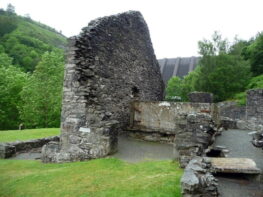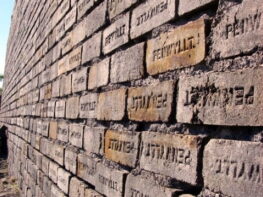
The Tintern Limekiln was used from the 1700s onwards and were out of use by 1850 (or some say 1902).
The kiln was filled with limestone from surrounding quarries and charcoal from the coppiced woodlands.
The Tintern Limekiln is a single kiln with two access arches. Production was continuous with two tunnels used alternately.
The lime was raked-out through the holes at the back of the tunnels and left to cool.
The working life for a limeburner was hard, dangerous and very unpleasant. In addition to the physical effort of shovelling tons of rock, the lime dust caused chemical burns as it settled on their bare skin, moist with perspiration from the heat and hard work; the billowing smoke and fumes also caused lung disease.
There is a car park at Tintern Abbey: Postcode: NP16 6SE, Grid Reference: SO533001
The walk to the limekiln from the car park requires you to cross the road and traverse the carpark of a a derelict pub! The path supposedly follows the line of the ancient Abbey perimeter wall, but it a muddy gully behind the end dwellings and perseverance will soon reveal the limestone quarry – the natural habit of the limekiln.

The Tintern Limekiln was used from the 1700s onwards and were out of use by 1850 (or some say 1902).
The kiln was filled with limestone from surrounding quarries and charcoal from the coppiced woodlands.
The Tintern Limekiln is a single kiln with two access arches. Production was continuous with two tunnels used alternately.
The lime was raked-out through the holes at the back of the tunnels and left to cool.
The working life for a limeburner was hard, dangerous and very unpleasant. In addition to the physical effort of shovelling tons of rock, the lime dust caused chemical burns as it settled on their bare skin, moist with perspiration from the heat and hard work; the billowing smoke and fumes also caused lung disease.
There is a car park at Tintern Abbey: Postcode: NP16 6SE, Grid Reference: SO533001
The walk to the limekiln from the car park requires you to cross the road and traverse the carpark of a a derelict pub! The path supposedly follows the line of the ancient Abbey perimeter wall, but it a muddy gully behind the end dwellings and perseverance will soon reveal the limestone quarry – the natural habit of the limekiln.







